By Peter Sanderson, 13 April 2023.
The early 1950s were a busy time for the Canadian Forces. As a founding member of NATO, the Army sent 27 Brigade and the Air Force provided an Air Division. Then there was the Korean War with 25 Brigades on the ground and elements of the RCN and RCAF which all saw action. Canada was classed as ‘middle power’ on the strength of CF which allowed Canada’s leaders to take an active role in world events.
1956 SUEZ CRISIS & UNEF. Canadian UN Representative Mike Pearson gets the belligerents to accept an UN Peacekeeping Force. The Canadian Forces played an important role in UNEF. While the troops flew on RCAF Transport Command, stores and vehicles were put aboard the aircraft carrier HMCS Magnificent for the trip to Egypt. The carrier was used to accommodate a small hospital and force headquarters, and to provide a communications link to Ottawa.
1964 CYPRUS CRISIS & UNFICYP. Violence had broken out between the Greek and Turkish Cypriot communities. Turkey threatened to invade the island if the UN didn’t quickly send in a Peacekeeping Force. Once again a Canadian, Minister of External Affairs, Paul Martin, soon corals the stake holders and gets an UN Peacekeeping Force approved. Canada was now part of UNFICYP. While the troops flew on RCAF Transport Command, stores and vehicles were put aboard the aircraft carrier HMCS Bonaventure for the trip to Cyprus.
THE AMPHIBIOUS SHIP. If Canada wants to get out of the ‘garrisoning Europe’ trap and move to a ‘reinforcing Europe’ model, it will need a LHD or LPD. If the Mistral is chosen, it is a dual use ship since its hospital allows it to be used as Humanitarian Assistance ship. The LHD needs a similar facility that you would find for a car transport ship – a long berth adjacent to a large secure car park. When the Army seconds the LHD for an amphibious exercise, the ‘default load’ of emergency construction equipment must be unloaded to free up the vehicle deck. The Battalion Battle Group equipment from Gagetown, would arrive on a long train of flat cars loaded with tanks, TAPVs, LAVs, artillery and engineer vehicles, CPs, field kitchens, fuel bowsers, recovery and maintenance and trucks loaded with ammo and rations. These vehicles need to be unchained and driven onto the LHD and re-chained. The troops would arrive in buses. Four weeks later the process is reversed.
LANDING IN EUROPE. The ‘Unopposed Amphibious Landing’ still requires a ‘foot-on-the-ground.’ Since the beach head and surrounding area would has been monitored all night by a Gargoyle, the Venoms can take off at first light, with their first load of infantry, who will secure and guard the beach head perimeter. As the Venoms fly single file towards land, they are guarded from marauding fighters by the flanking Vipers. The Viper, unlike its big brother the Apache, can carry and use 2 full size anti-aircraft missiles. Meanwhile in the well deck, the L-CATs are being loaded the TAPVs, NEMO LAVs and Caesars. When the TAPVs reach the beach, they will race off with their accompanying drones, to conduct their Route Recce; while the 155mm guns of the Caesars 6x6 Mk 1 will provide a 3 to 40 km umbrella for the beach head. The 120mm NEMO mortar system has a 0 to10 km reach and will provide Final Protective Fire (FPF) if withdrawal is necessary. Over the day, each of the 3 Combat Teams will be completed and will then move out on its road move. Our Expeditionary Force has been delivered in about 12 to 14 days from start to finish.
NATO READINESS TASKING. Once the LHD arrives, Canada can apply for a ‘Battalion Battle Group’ Readiness Tasking since it can be delivered in less than 30 days. The unit would first have to be certified and then attend an annual NATO exercise to retain it.
France calls the Mistral BPC a “command and power projection” ship which is exactly what Canada did in 1956 and 1964 and what it would be doing when reinforcing Europe.
REFERENCES:
1. Pp 248-251, 258-261 The Armed Forces of Canada, 1867-1967 - LCol D J Goodspeed, CD DHist CFHQ 1967 -

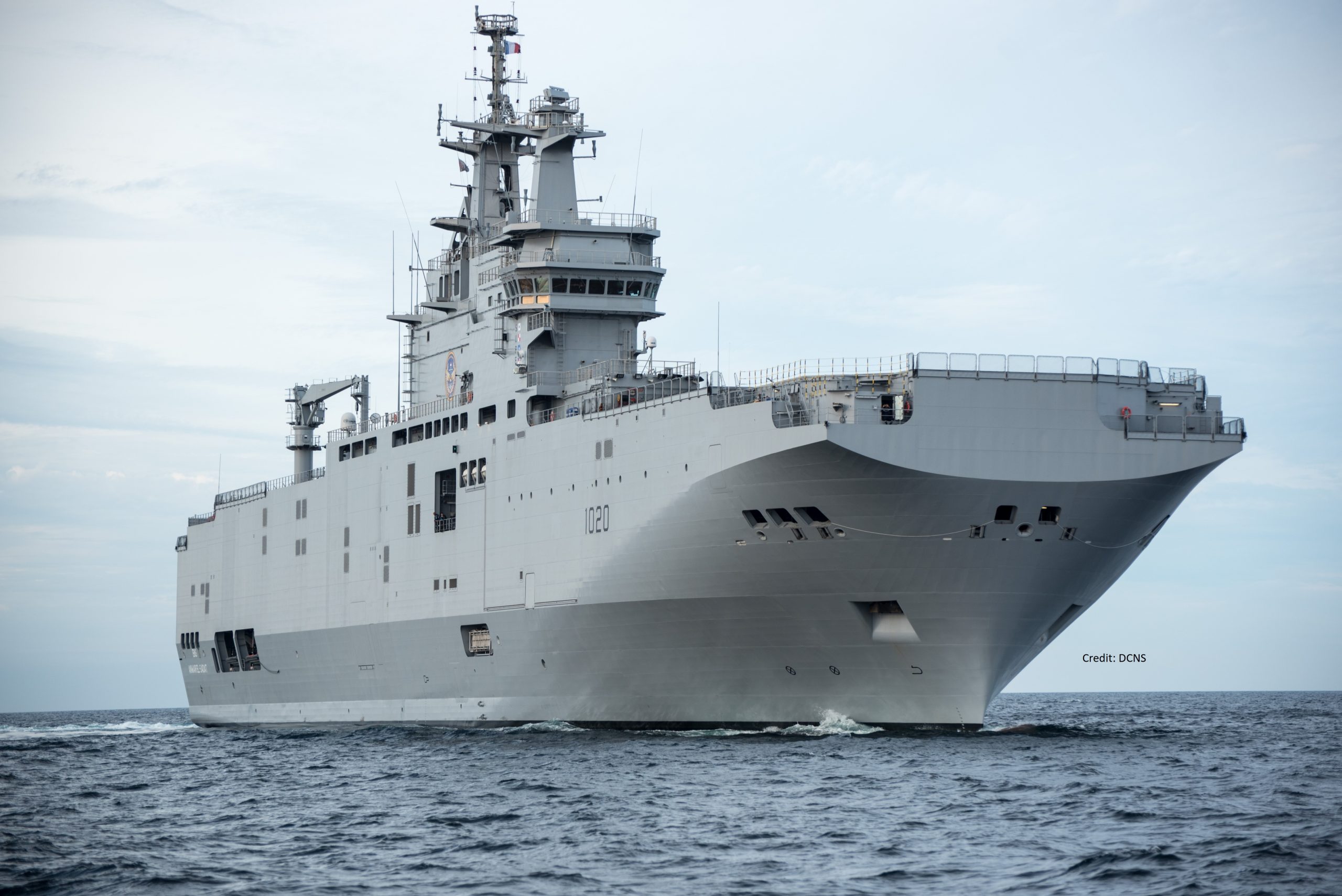
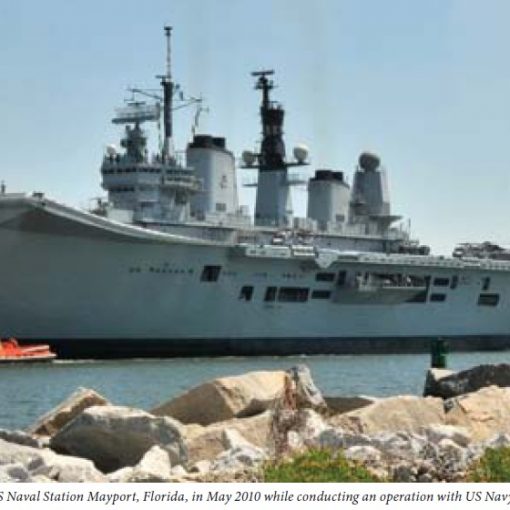
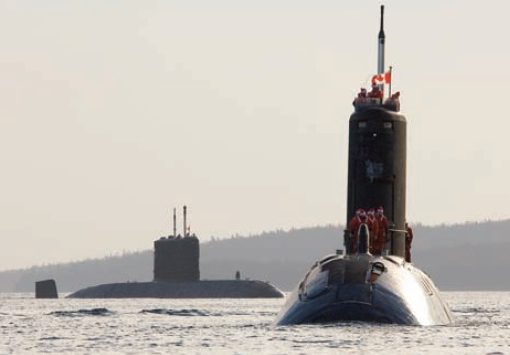
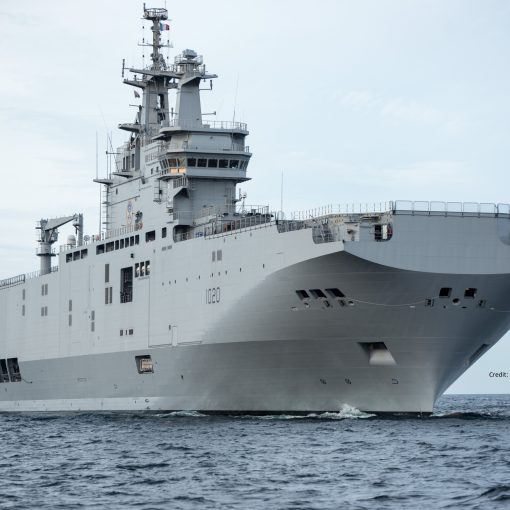
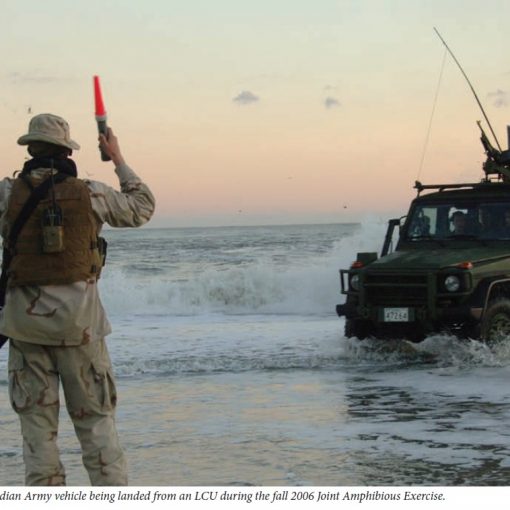
18 thoughts on “How the RCN delivers an Expeditionary Force – then and now”
I think the Mistral is a case of sprinting before we can walk.
The Mistrals are very crew hungry even when lean manned to 160. The reality is you’re looking at a crew of 230+ if you’re including air wing, and more if you’re including the amphibious side of things.
The ships themselves would not as some have stated be able to operate F35B (physically impossible in current form), so there is a limitation on what you can carry in regards to helicopters. Transport helicopters such as Chinook and Cormorant would be the mainstay no doubt but that is going to limit numbers carried due to the size of the helicopters.
We also have to look at how many Mistrals to add to the fleet. The reality is you would need at least 2 – one for each fleet. The other side to the Mistrals is they are slow, less than 20 knots.
They cost 685 million euros each when they were built and have now been out of production for quite some time, any re-start is going to add major costs to restart so potentially you could double the 685 million per vessel.
In my opinion forget the Mistral. It’s a dead duck. If you want to look at something more feasible and also more palatable to government that’s not that expensive and can limitedly do what a Mistral can do, then we need a closer look at the Absalon class.
Good morning Blair,
You make excellent points.
Having argued for a Mistral-like capability in the past (2006), I now believe that we instead need ships that can operate in our Arctic, as well as elsewhere.
The Absalons offer a valuable start point for discussing such a ship in terms of the amphibious capabilities that can be fit into an Arctic-capable hull of their length, see CNR 17.1 pp 33-35, CNR 18.1 pp 31-34, and CNR 18.3 pp 30-32 for discussions of such an Arctic amphibious ship.
In the situation where Canada does not wish to buy Arctic-capable ships, a non-Arctic-capable Absalon design might have some value for the RCN.
One of the key features of the Absalon class is they were designed to operate in the arctic around Greenland so they have some limited ice capability. (Ok they are not polar 5 rated but still it’s more than what we have.)
If we want ice capability and a multi-role design then we can certainly have a look at a stretched Harry DeWolf which is similar beam size but 130ft shorter similar displacement. The multi-role option would give the RCN a significant boost in amphibious operations plus logistical support especially in HA/DR operations.
We did miss the trick back in 2014 when the French were looking for buyers of the 2 Mistrals we could (should) have snapped them up but we let them go sadly.
I did get to go on Ex Sevastopol (Now Anwar al Sadat) and also Dixmunde in St Nazaire & Toulon. They are very good LPH vessels. They are very capable and both would have slipped nicely into the RCN. What’s more, they would have made the decommission of Iroquois more palatable to the navy given the increase in capabilities and indeed the army who would have enjoyed gaining new taskings.
Overall though and excuse the pun but the Mistral ship has sailed.
A thought to consider if we want a non-Arctic-capable Absalon is something similar to the small Italian San Giusto LPD. Similar tonnage to Absalon but with a full length flight deck and a well deck.
Still think though that Arctic-capable LPAs and LSI(A)s are what we need if we embark on the amphibious route
Good morning
There is a lot more complexity that goes with operating a LPH type vessel and the RCN lost all its experience operating a full flight deck back in the 70s so there would be a need to rework new crew for that role.
Can you build a LPH cheaply? Yes you can HMS Ocean is a good example of a cheap yet effective LPH. Downsides to her was she was a commercial design she was slower (18knots full ahead) and the crew were glad to see her go by the end. I spoke with several MEOs & stokers that got redrafted after her sale and they told me that she was an absolute nightmare to work on and one of the most hated draftings in the RN.
Overall I think we need to review the whole role and doctrine of the RCN before considering amphibious capability.
I’d also point out that the Italians have had quite a lot of trouble with that class and it is why the follow on was much larger.
Hello,
It seems reasonable for a large maritime nation to have a well developed amphibious capability.
That said, under what scenario would we carry out an amphibious landing to reinforce Europe? In response to what threat and what opponent?
None of the examples cited were against a “peer” adversary.
Is the assumption that we would deploy in response to a Russian invasion of western Europe? When was the last time the Russian army occupied a western capital, at what price, and for what political reason? Paris 1814 after pushing back Napoleon, Berlin 1945 after pushing back Hitler?
So what would be the political aim of our amphibious deployment? Considering the lessons being (re)learned about modern industrial warfare in the Ukraine, and considering modern long-range sensor and missile capabilities, I don’t think the expectation of an ‘Unopposed Amphibious Landing’ is reasonable.
Regards,
May I suggest that you look at my post above of 22 Apr 23 about part of my idea for an Arctic amphibious capability for sovereignty protection (discussed further at CNR 17.3 pp 20-22 and a number of other articles) which I consider to be essential for Canada.
A non-Arctic-capable Canadian amphibious capability is, to my mind, a nice-to-have. Arctic-capable amphibious forces can however carry out various missions in non Arctic water, see CNR 18.2 pp 23-27.
@Blair Shaw x 2 (24 Apr 23)
Thank you for the info on the British and Italian amphibious ships.
With regard to future roles for the RCN I suggest that it needs to be able to deploy expeditionary forces in support of Canada’s long-standing ‘distant defence’ strategy while also being able to undertake coastal patrol and defence operations, especially in the Arctic (see CNR 17.3 pp 20-24 for further thoughts on this idea).
I shall take a look I may have already read it but will refresh
Perhaps a LPD would be another option something like the Albion or bay classes
Hi Blair,
I look forward to hearing any thoughts that you may have on the CNR article.
An LPD certainly offers more capability than an Absalon-like vessel. However, I feel that any such purchase must have an Arctic amphibious capability, as well as the ability to carry out other missions. In fact, the LPA that I propose in CNR 18.2 (pp 23-27) and elsewhere is such a vessel.
Good evening Les
I couldn’t view 18.2 hadn’t realized my subscription has expired and now I cant login either I will sort this out at a later date, but I did read 17.3.
I agree with most of what you have said in this article, yes commercial shipping will want to explore the North West passage and this in itself puts Canada in a sticky spot.
As Canada claims these waters as sovereign it means Canada could potentially charge tolls on the route, however If Canada claims they are territorial waters and does not wish to open them up for international shipping your going to need forces capable of forcing the issue.
I point out that if the UN states that the NW Passage is indeed an international waterway it means I believe (I will verify this from my law book later) Canada must have by international law a capable search and rescue forces in the area, and being classified as an international waterway means Canada may not be able to charge tolls and may indeed need to set up a TSS (The UK and France do this in the English channel and cannot charge tolls).
Overall The Harry de Wolff class are not amphibious ships however, given a bit more length and a roll on roll off deck they could become an expeditionary unit capable of taking equipment and supplies north.
In my view all you need up there onboard the ships is a detachment of army as reinforcements can be taken over land or via air, your only going to use the seaborne troops realistically to board vessels and also any heavy equipment can be bought up and discharged ashore but then again here’s where you can put one of the ferries onto a charter to do that job.
A Mistral class for example would be wasted in the Arctic IMO, while they are great for HA/DR and certain other roles they are large vessels, they are slow and require a lot of crew to operate them, they are also expensive to operate and maintain not to mention build.
When you mention capability in terms of sealift the LPD will win out, I can fit so much more onto a LPD than I can an auxiliary (Except the point class or Bay class) but what you do have with an LPD is key vulnerabilities in all areas.
In contested spaces the LPD and indeed a LPH is incredibly vulnerable to all threats, HMS Albion & Bulwark plus the Bay class for example will always have to be paired with at the very least a frigate.
This is due to the fact they have no AAW ASuW or ASW capability they barely have point defense capability, this means it now subtracts a major combat platform for escort duty when realistically if you had something like Absalon she could go alone, thus your stretching an already limited fleet.
I am a very keen supporter of the Absalon class, I have been on Esbern Snare and worked with them during several BALTOPS, while yes they have very limited roll on roll off and amphibious capability the fact is they can hold their own in contested space plus they can also act as a frigate in their own right.
What that design does is allow the already limited major surface unit to be free for other tasking, and if required you can integrate the Absalon into a medium tasking alongside the frigates (we did this in Joint Warrior) thus in essence you have the 15 CSC frigates plus 2 Absalon LPD that can bulk the frigate force to 17 (although I would for cost reasons reduce CSC to 13 but you would still get 15 surface ships)
Another good point you make in the article is the JSS ships, 1 per fleet would be great and yes I agree we should look at another conversion like Astrix (as well as retain Astrix), however It isn’t all about oilers we need to look potentially at mixed role support ships like RFA Fort Victoria, these vessels offer solid stores (munitions food etc) plus some limited fuel oils and Aviation fuel.
Over all though we must remember that Canada is not a global power nor is it a blue water navy like the Royal Navy, but Canada could do more with logistics and indeed offset the cost using the Federal Fleet Services this would be similar in set up to the Royal Fleet Auxiliary or MSC of the USA.
A big key note I would like to also point out is our merchant fleet, apart from some lakers and ferries there is not much else under the Canadian flag sailing globally, this is a strategic asset for times of war, indeed in 1982 the UK took up from trade many merchant ships flying the British flag, they did this again in 2003.
Logistics wins wars we have known this since pre biblical times and it is an area I think Canada should put some more effort into rather than relying on its allies.
One of the key issues facing the RCN is recruitment and retention right now, where do you find the crew for such large and numerous platforms, bear in mind you state in your article you would like to see 8 submarines as well, don’t forget if we get all 15 CSC frigates they all have to be crewed as well.
Another big stumbling block is government, for years and I think we can both agree various governments have sat on their hands and ignored defense, they have kept kicking the can down the road with various projects and now the time has come to replace the already overdue platforms and they have all come at once.
We are looking at the CSC frigate, Submarines, and Patrol craft these are all big programs and they have all come up at once, the real trick with programs is to spread them out because if we start all these programs at the same time they will be due the same time in 30 years.
This isn’t due to the RCN this is due to various governments kicking that can down the road, and right now I can honestly say with so many expensive programs now requiring urgent replacement any increases might be too much to bare for the political classes.
I would absolutely love 8 or 12 submarines in the RCN however I do think it is such a big jump doubling or tripling the force and the reality is the current fleet don’t have a lot of sea time plus all the other issues etc that have gone on so crews are not being given the tool to do the job.
On top of this we seem to be very fixated with global operations, conventional and AIP submarines have limitations and while the odd deployment around to certain areas of the globe gives Canada enhanced presence the fundamental mission for our submarines should be to protect Canadas coast line from intrusion by foreign submarines and ships.
Even AIP submarines require long transit times so I think we need to refocus what we want from these submarines, and what our operational doctrine should be going forward, as I said Canada is not a blue water navy and not a global power so do we really need to deploy these submarines routinely to the far side of the world.
An even bigger issue for the RCN is recruitment and retention, now lets add in the bill for a LPA/LPH type vessel plus 4 more submarines than just replacements I could honestly see government going loopy at that thought as we know they don’t like spending on defense anyway.
I Do think we must be more modest given the current situations regarding procurement, I have to say having worked with the RCN in this area for Logistics and supply chain matters they are pretty poor performers all round then add in the MPs and government officials plus the other defense programs that have gone wildly over budget in the past and well I can see it being a non starter or cancelled part way through.
Good morning Blair,
Thank you for your detailed and thoughtful comments on my post. I must say that I agree generally with what you say and fully with nearly everything.
In my discussions about a Canadian Arctic Amphibious capability I use the term Landing Ship Infantry (Arctic) (LSI(A)) to describe a vessel like the Absalons, that does not have a well deck, which is Arctic capable. It is described at CNR 17.1 pp 33-35 and discussed further at CNR 18.3 pp 30-32.
The latter article tries to address some of the real world concerns that you raise.
Given your practical experience with the actual Absalons, I would be very interested in your thoughts on the two articles.
My fast and dirty answer to this is to get Davie (they seem to be the only shipyard in Canada that gets things done at less than twice the cost) to modify a couple of RO/ROs large enough to carry a battle group of 1/3rd of a brigade, all its equipment and stores for the first month. It will have a helicopter deck, a command and control suite and a hospital. Not freaking rocket science. We argue the point and dither for so long in this country that we lose capability. Then we wind up shipping our kit on crappy former Soviet airplanes and using “fly by night” ship companies where we have to do commando raids to recover our kit. I’m sorry to say if I was the CDS or the Commanders of the RCN, RCAF and Canadian Army, I would resign either in protest — that Denmark could invade us and probably win, if it wasn’t for the fact they are our ally, or out of shame for dereliction of duty for not having the backs of our deployed personnel.
And what exactly would your RO/ROs do? Peacetime sealift in non-Arctic waters?
No actually what I am saying is build the new Frigates before the Halifax Class ships are as worn out as the St Laurent Class were in the 1980’s, get the new AOR’s built so that we can support them at sea and yes keep the Asterix too. Replace the Victoria Class submarines with something that can track submarines under the ice, because we can track Russian and Chinese Ice Breakers, but we can’t track or intercept Russian or Chinese Submarines under the ice pack. The LDP’s are a nice thing to have, but until we replace the core of our Navy, we need to put our Champagne wishes aside and get as much as we can with our beer budgets. But if we could I would look at the RO/RO like the USNS Bob Hope Class, it is reasonably fast, has twin screws unlike a civilian RO/RO. It could be modified to do 95% of what we would need it to do. It also can carry more than 1 tank or 2 LAV’s. If you want it to be a Ice Class 2 capable ship then you are back to cost. I think the AOP’s are not great but work fine for Class 5 Ice, though better armed and space to store combat equipment for the Army would have been nice. However all that being said our Government has starved the Forces of new equipment, by not using allocated funds and uses the Forces for everything but defending our country. Don’t get me wrong I think our troops are wonderful out fighting forest fires and floods, but they are literally supposed to close with and destroying the enemy, not hosing down fires, or taking COVID tests. Why does anyone even remotely think that suddenly this government or any other in Canada would buy an LDP or two. I’d rather them push to get the new ships we need built faster, if only because we might need them sooner than we take delivery of them. I’m trying to be realistic!
I also think that Senior General Staff of the Forces needs to show some leadership and tell the Government why they need to do a better job of supporting those who are putting themselves between potential enemies and us and if they can’t make that happen then resign and add to this governments shame. That is called loyalty to your troops and leadership. Something we seem to have way too little of in the Forces theses days.
Good morning Einar,
Thank you for your response. Setting aside your very strong views about the CAF leadership, I would like to comment on some of your points.
I agree fully with the need to bring the planned ships into service more quickly than the NSS seems designed to accomplish. However, I believe that the government and CAF leadership must as well review the national strategy that these ships are supposed to support. Specifically, how much of the available resources should we allocate to distant defence and how much to coastal (ie. Arctic) patrol and defence. I have argued elsewhere that the current allocation seems too heavily weighted towards distant defence.
With this view in mind, I also agree that traditional LPDs (and other such amphibious ships) are nice-to-haves that will not be funded. I include RO/ROs in this category. They would have little value other than for several missions during peacetime only. I believe, though, that Arctic-capable LPAs and LSI(A)s are a completely different matter.
I have not seen any info that the AORs will be Polar Class 5. Can you provide a reference? Additionally, Arctic-capable ships do not have to be either Polar Class 2 or Polar Class 5. Polar Classes 3 and 4 have great value during the annual Arctic navigation season and the months preceding and following it.
Finally, not being there when Canadians need them (forest fires, Covid-19 response, prison breaks, etc) is a great way for the CAF to be seen as irrelevant (and thus undeserving of its budget) by the Canadian taxpayers. Such missions are not related to the CAF’s primary combat mission but they are the logical result of being the one group of disciplined and capable individuals who will show up and do what is needed quickly and on short notice. Such missions are must-succeeds.
Ubique
Les
Sorry I didn’t reply sooner Les. The AOP’s were specified to be Class 5 Polar, which is first year ice. The Naval Association of Canada has stated that the Harry DeWolf Class is Class 5 but the “bow has been strengthened to Class 4” Look the class up in Wikipedia and then follow the link in the design section.
Regarding using the Canadian Forces to fight fires and be do other civil defence projects. If our service people are not getting sufficient military training then they cease to be military personnel and become a civil defence personnel. Having been both a firefighter and a soldier, it literally is putting those who are not trained in wildland firefighting at risk of being killed horribly, even professionals do that frequently, but at least are trained and understand the risks. Maybe Canada and Canadians need to decide whether we want to have our soldiers be a deterrence to countries and others who may want to do us harm before they get to our borders or we want a civil defence force. If the latter then train them for that role, if the former do likewise. The Army, Navy and Air Force in this country are sick, and the only way this changes is when the leaders of the Canadian Forces make it stunningly obvious that something is wrong to all Canadians so that our political leaders are shamed into funding some semblance of an Armed Forces that is capable of defending our national sovereignty and our international commitments. Your comment about our service persons needing to show Canadians their value by “pouring water on fires etc” – was not the Balkans enough, was not Afghanistan enough, is not the fact that many served in almost poverty because of their loyalty and desire to serve enough? Maybe Canadians need to prove they support our troops even after the warfighting is done.